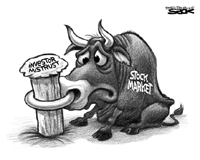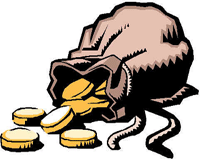The Psychology of Investing in the Stock Market From 1996 to 2007
Stock-Markets / Trader Psychology Dec 09, 2007 - 12:52 AM GMTBy: David_Petch
 Taxidermy refers to the job of taking the skins of dead animals and mounting them onto a plate of some form that depicts them in a naturally occurring state. With the era of photography and cartoons, this is not required for today's article. Instead, pictures are strategically placed onto the S&P 500 Index chart to “capture” what the general populous was thinking at a particular point in time.
Taxidermy refers to the job of taking the skins of dead animals and mounting them onto a plate of some form that depicts them in a naturally occurring state. With the era of photography and cartoons, this is not required for today's article. Instead, pictures are strategically placed onto the S&P 500 Index chart to “capture” what the general populous was thinking at a particular point in time.
One of the main reasons for this article taking along time to publish was finding the appropriate pictures. A picture is said to be worth 1000 words, so each picture is supposed to be representative of the thoughts of each individual at a certain point in the stock market cycle. The stock market is a barometer of how the economy is doing and the footprint left by the "tape" directly captures the summation of all participants. Many assume the market is a random beast that does not follow any particular pattern, but instead, quite the opposite is true.
Elliott Wave Analysis is one of the hardest forms of technical analysis to master due to the complex interactions of reading multiple indicators, Fib retracements and extensions, Fib dates, pattern recognition, Ordering the "Degree" of a count etc. etc. If someone can accurately determine the type of pattern developing and where one resides within the structure, a semi-quantitative "guess" can be made as to where the markets will be heading in the time frame under study.
I am a fan of Mixed Martial Arts…watching, not participating because I would become meat very quickly. Technical analysis must be performed in a similar fashion to MMA, excelling at one particular area, but being overall "well rounded" in all disciplines (grappling, striking, jui jitsu, judo, submissions, balance, flexibility, strength, endurance). Each particular area is required to be successful because one's opponent may have some trick up their sleeve that one may not be good at and lose a match due to being controlled in that one particular area (i.e. a very good striker may be useless on the ground and get submitted through an armbar). In our case, each individual investor faces their opponent (the market) on a daily basis, whereas MMA fighters only fight 4-6 times/year due to potential injury.
The injury of the individual investor can take several forms, from financial losses to emotional trauma caused by losses. It is the job of the investor to understand the basics of market psychology and what they represent at particular moments in history, so that they can be applied going forward. Mark Twain once said "History never repeats itself but it often rhymes", and as the following analysis will show, this is so true making this one of the most famous quotes of all time.
The chart below has several different pictures to capture the general market psychology along the trek of the S&P since 1996 till present. Each picture will subsequently be presented with accompanying text highlighting historical incidents that were going on in the background, which was driving public sentiment.


Blue Sky Potential: During 1995-2000, intermixed with some turbulent times brought about by Long-term Capital Management, stocks were in a bull market. People as a whole were starting to feel richer, particularly those living in the US due to the strength of their currency. Stocks such as Nortel and Cisco Systems, JDS Uniphase, Adobe, Yahoo, Amazon created millionaires who were invested to the gills. Life was good, everyone thought that blue skies would continue with the odd bump along the way. People were holding their investments, governments appeared to be getting their books in line (although this was through deceptive accounting). There were a lot of prominent bears that said the market had topped, which was evident with ridiculously high put/call ratios. As such, there were enough bears out there to suggest the markets would continue to rise.
 “Be a Pig”: To quote the line of the TV Show the Grizwald's were on in European Vacation. But blue skies suddenly changed when an overwhelming percentage of the public jumped on board and decided they wanted to get rich and live the dream like those who rode Nortel up from $2 to $55/share. By mid 1999, even the last bear had thrown in the towel and embraced the new era. The Internet was going to be the biggest and best thing, high speed was in its infancy, with dial-up still a common method of "logging on". As such the Internet "had" to be rolled out at a faster pace because according to the pundits we were 20 years behind.
“Be a Pig”: To quote the line of the TV Show the Grizwald's were on in European Vacation. But blue skies suddenly changed when an overwhelming percentage of the public jumped on board and decided they wanted to get rich and live the dream like those who rode Nortel up from $2 to $55/share. By mid 1999, even the last bear had thrown in the towel and embraced the new era. The Internet was going to be the biggest and best thing, high speed was in its infancy, with dial-up still a common method of "logging on". As such the Internet "had" to be rolled out at a faster pace because according to the pundits we were 20 years behind.
Technology was going to save the world and P/E ratios could be thrown out the window because we were in a "new era". Companies appeared to have monopolies in certain areas, which led investors to believe their high valuations were justified…or were they? The speculative fervor of 1999/2000 can be compared to the recent housing bubble of the US , which peaked in late 2005. Bad news did not seem to matter, no matter how bad or how loud it got. This is because bull markets are more often than not the result of a "Wall of Worry", where when anxiety about the future disappears, an end is usually not far behind.
 Bull Market has been Corralled : After the March 2000 peak in all broad market indices of North America , the bear market commenced. Bear markets are often referred to as "The Slope of Hope" where people "hope" for a return to the good days. Some people with money "think" they can control the market by purchasing a large chunk of shares in a particular stock.
Bull Market has been Corralled : After the March 2000 peak in all broad market indices of North America , the bear market commenced. Bear markets are often referred to as "The Slope of Hope" where people "hope" for a return to the good days. Some people with money "think" they can control the market by purchasing a large chunk of shares in a particular stock.
The stock market functions as a collective and when particular sectors are in a bear market, all stocks within those areas will follow suit. Anyone who has tried playing this game ends up losing. The feelings of greed and euphoria quickly disappeared in 2000 and 2001. People kept on saying, "These are only paper losses if I sell" and they rode the stock market all the way down to the bottom "waiting" to sell for a profit when the markets turned around…they never did.
 Return of the Benson Buggy Era or simply postponed : By March 2003, most people who rode the market down were washed out and felt like those in the 1930's …financially ruined. Generally, whenever large bull markets terminate, the price of real estate historically falls. Since the world went off the gold standard in August 1971 with Nixon's signature on a piece of paper, global inflation has been picking up steam ever since. To keep the ball rolling means that more and more drastic measures must be taken at each crisis point or it all ends. To prevent a depression in 2000, the US FED lowered the overnight lending rate to 1%, which created a lot of easy money.
Return of the Benson Buggy Era or simply postponed : By March 2003, most people who rode the market down were washed out and felt like those in the 1930's …financially ruined. Generally, whenever large bull markets terminate, the price of real estate historically falls. Since the world went off the gold standard in August 1971 with Nixon's signature on a piece of paper, global inflation has been picking up steam ever since. To keep the ball rolling means that more and more drastic measures must be taken at each crisis point or it all ends. To prevent a depression in 2000, the US FED lowered the overnight lending rate to 1%, which created a lot of easy money.
The easy money and flood of credit introduced by banks to increase the velocity of money started, which lead to an increase in real estate while the business sector entered a recession. What should have been a return to an era of the Benson Buggy was postponed as people borrowed and used their houses as a personal ATM to buy that new flat screen TV or shiny new SUV. A large percentage of the public felt like the above picture however and simply exited the stock markets, vowing never to return. Currently around 70% of all trades are done using computers by the large mutual/pension/hedge fund companies, so the "small guy" was quite removed from the markets by March 2003.
 The Collective Borg (Star Trek) or Should I say “The Collective Homer's?”: After a period of some 3 years from the March 2003 lows, most investors have become numbed by all of the bad news and are investing as if their brain had the capacity of our friend Homer above. The S&P is still in a bear market, so the "Slope of Hope" is still in play. Instead of Yahoo or Nortel, there is now Google which one share will buy a really expensive night on the town. The fiscal irresponsibility of Central Banks is evident by the mountains of derivative paper that is starting to blow up.
The Collective Borg (Star Trek) or Should I say “The Collective Homer's?”: After a period of some 3 years from the March 2003 lows, most investors have become numbed by all of the bad news and are investing as if their brain had the capacity of our friend Homer above. The S&P is still in a bear market, so the "Slope of Hope" is still in play. Instead of Yahoo or Nortel, there is now Google which one share will buy a really expensive night on the town. The fiscal irresponsibility of Central Banks is evident by the mountains of derivative paper that is starting to blow up.
These financial bombs are being wrapped up with more and more derivatives where they may soon be called "Integrals" to raise their power. All of the newly created derivatives are simply transferring the "Day of Reckoning" into a later date in the future. Based upon examination of some 500 trillion plus dollars in derivatives, the hyperinflation of today is to try and keep the global economy functioning. We live in an era where bank computers can add money to their currency with some "extra zeros" with the stroke of a finger, rather than with sweat, blood, and tears of the past where an ounce of gold represented so many dollars being eligible for existence in circulation. There has been a stealth bull market since 2000 that has gone unnoticed by the general public, further adding to the Homer Collective.
The game going on is a game of musical chairs and when the music stops, there are only so many people who will find a seat. The majority of the public will be trying to buy a seat, but the price will be steep. Owning gold and silver bullion and precious metal companies that have an operational mine is the next game in town where the next bubble will soon reappear. Bull markets in gold are usually based upon fear, not greed. People will panic to do whatever they can do to preserve their wealth under the blanket of fear, which is a far more dangerous emotion than greed. With fear, people simply "lock up" their cognitive abilities and function with the ancient emotion of "fight or flight". There will be a "flight" to quality, which will be gold bullion, followed by silver bullion.
 Gold is Money : At some point in the not too distant future, global fiat currencies will collapse in value against commodities, and the cost of living will soar. People will go on a head hunting campaign and demand Central Bankers of the globe be forced to do hard labour deep in the mines of the Earth to extract gold with a pick and shovel (to show how really difficult it should be to introduce fiat currency into the market). A new age will be born where countries that have a gold-backed currency will control the wealth of the world.
Gold is Money : At some point in the not too distant future, global fiat currencies will collapse in value against commodities, and the cost of living will soar. People will go on a head hunting campaign and demand Central Bankers of the globe be forced to do hard labour deep in the mines of the Earth to extract gold with a pick and shovel (to show how really difficult it should be to introduce fiat currency into the market). A new age will be born where countries that have a gold-backed currency will control the wealth of the world.
Central banks that sold gold are going to have their local currency valued like those of the past that inflated theirs away. An era of "honest money" will be established with a new set of players…the old ones will become the new "Boys From Brazil"; or, whatever country is viewed as the next hideout of choice. The way to be a part of the "Gold is Money" era is to start buying gold and silver bullion while it still is available. Purchasing gold and silver stocks should be restricted to companies that have an operational mine, with minimal share dilution, good management and located in politically secure countries. Failure to do so will add another member to the Homer Collective.
By David Petch
http://www.treasurechests.info
I generally try to write at least one editorial per week, although typically not as long as this one. At www.treasurechests.info , once per week (with updates if required), I track the Amex Gold BUGS Index, AMEX Oil Index, US Dollar Index, 10 Year US Treasury Index and the S&P 500 Index using various forms of technical analysis, including Elliott Wave. Captain Hook the site proprietor writes 2-3 articles per week on the “big picture” by tying in recent market action with numerous index ratios, money supply, COT positions etc. We also cover some 60 plus stocks in the precious metals, energy and base metals categories (with a focus on stocks around our provinces).
With the above being just one example of how we go about identifying value for investors, if this is the kind of analysis you are looking for we invite you to visit our site and discover more about how our service can further aid in achieving your financial goals. In this regard, whether it's top down macro-analysis designed to assist in opinion shaping and investment policy, or analysis on specific opportunities in the precious metals and energy sectors believed to possess exceptional value, like mindedly at Treasure Chests we in turn strive to provide the best value possible. So again, pay us a visit and discover why a small investment on your part could pay you handsome rewards in the not too distant future.
And of course if you have any questions, comments, or criticisms regarding the above, please feel free to drop us a line . We very much enjoy hearing from you on these items.
Disclaimer: The above is a matter of opinion and is not intended as investment advice. Information and analysis above are derived from sources and utilizing methods believed reliable, but we cannot accept responsibility for any trading losses you may incur as a result of this analysis. Comments within the text should not be construed as specific recommendations to buy or sell securities. Individuals should consult with their broker and personal financial advisors before engaging in any trading activities as we are not registered brokers or advisors. Certain statements included herein may constitute "forward-looking statements" with the meaning of certain securities legislative measures. Such forward-looking statements involve known and unknown risks, uncertainties and other factors that may cause the actual results, performance or achievements of the above mentioned companies, and / or industry results, to be materially different from any future results, performance or achievements expressed or implied by such forward-looking statements. Do your own due diligence.
Copyright © 2007 treasurechests.info Inc. All rights reserved.
Unless otherwise indicated, all materials on these pages are copyrighted by treasurechests.info Inc. No part of these pages, either text or image may be used for any purpose other than personal use. Therefore, reproduction, modification, storage in a retrieval system or retransmission, in any form or by any means, electronic, mechanical or otherwise, for reasons other than personal use, is strictly prohibited without prior written permission.
David Petch Archive |
© 2005-2022 http://www.MarketOracle.co.uk - The Market Oracle is a FREE Daily Financial Markets Analysis & Forecasting online publication.



